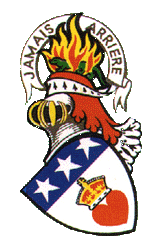|
The Earl's Palace is a ruined Renaissance-style palace near St Magnus's
Cathedral in the centre of Kirkwall, Orkney, Scotland. Built by Patrick,
Earl of Orkney, its construction began in 1607 and was largely
undertaken via forced labour. Today, the ruins are open to the public.
The palace was built after Patrick, Earl of Orkney, decided that the
accommodation provided by the Bishop's Palace was inadequate for his
needs. Earl Patrick is widely acknowledged to have been one of the most
tyrannical noblemen in Scotland's history. He decided to extend the
complex by building a new palace on the adjoining land. This was
complicated by the fact he did not actually own this property. He
quickly acquired it by fabricating charges of theft against the
unfortunate owner, trying him and having him executed. Upon his
imprisonment at Edinburgh in 1609, his bastard son Robert began a
rebellion on his behalf and seized the palace, along with nearby St
Magnus's Cathedral and Kirkwall Castle. An army led by the Earl of
Caithness laid siege, and the Castle was destroyed. Earl Patrick and his
son were later executed for treason.
The palace continued to be the residence of the Bishops of Orkney
sporadically until 1688, when it became the property of the Crown, and
fell into ruin in the 18th century.
The palace is currently in the possession of Historic Environment
Scotland as a protected scheduled monument. The ruins are roofless but
still reflect the original French-influenced Renaissance architecture,
with turrets and decorations carved in sandy coloured stonework.
The Earls of Orkney and The Douglas connection
The Orkneys and Shetland, and the Earl’s Palace have a connection with
the Douglas clan.
 On
the tombstone, in St Magnus Cathedral, of George Douglas, who died in
1611, and Elizabeth Douglas, his spouse, who died in 1630, is a shield
bearing: Quarterly first and fourth, three piles, second and third, a
heart; overall all many mullets in fess. On
the tombstone, in St Magnus Cathedral, of George Douglas, who died in
1611, and Elizabeth Douglas, his spouse, who died in 1630, is a shield
bearing: Quarterly first and fourth, three piles, second and third, a
heart; overall all many mullets in fess.
In 1643 William Douglas, the 7th Earl of Morton, was
granted the “regalities” (that is the rights and privileges due to the
king) in Orkney and Zetland, as Shetland was known, by King Charles I.
Morton was one of the King’s strongest supporters. He had sold his
Dalkeith estate so he could advance £100,000, a massive sum at the time,
to the king at the outbreak of the War of the Three Kingdoms (also known
as the English Civil War). When Charles lost the war Morton retired to
Kirkwall and died there in 1648 of natural causes. His son died the next
year, and the 9th Earl inherited.
The Earl of Orkney was originally a Norse jarl ruling the the
archipelagos of Orkney and Shetland (Norðreyjar). The second earldom was
created in 1581 by James VI of Scotland. The Stewart earls were based at
Kirkwall Castle, which had been built by Henry I Sinclair. It was
demolished on the forfeiture of the title in 1614.
William Sinclair (1410–1484), last of the Sinclair Jarls, 1st Earl of
Caithness and 3rd Earl of Orkney married three times, first to Lady
Elizabeth Douglas, daughter of Archibald Douglas, 4th Earl of Douglas
with whom he had:
• William Sinclair, 2nd Lord St. Clair (1436) was, in the opinion of the
father, a wastrel, wherefore he was disinherited. His family received
only the Castle of Ravenscraig in Fife.
• Catherine Sinclair, married Alexander Stewart, Duke of Albany
• (second daughter, name not recorded)
He married (second) Marjory, daughter of Alexander Sutherland of
Dunbeath, and had 15 children.
The last creation of the earldom was in favour of the man who in 1735
would become the first Field Marshal of Great Britain, Lord George
Hamilton, the fifth son of William Douglas, Duke of Hamilton. The
peerage was created with "remainder to the heirs whatsoever of his
body", meaning that the title can be passed on through both male and
female lines. The title passed to the O'Brien family, then to the
Fitzmaurice family, and later to the St John family. The subsidiary
titles of Viscount of Kirkwall and Lord Dechmont were created at the
same time as the earldom. The present earl holds the subsidiary titles
of Viscount of Kirkwall and Lord Dechmont. Both subsidiary titles were
created at the same time as the earldom, in 1696.
William Douglas of Egilsay,
Orkney (and of Spynie?) (c. 17th Century) was a Burgh commissioner for
Shetland in 1667.
Sir Alexander Douglas (d. January
1718) was a Burgh and Shire Commissioner of Orkney and Shetland for the
Parliament of Scotland and was also the first MP to represent the
constituency.
Admiral Sir James Douglas, of
Springwood Park, was M.P. for Orkney and Shetland 1754-1768.
George Douglas,
13th Earl of Morton, was MP
for
Orkney & Shetland, and was succeeded by his son,
Colonel Robert Douglas (c.1703 – 30
April 1745) of St Ola, Orkney was a British Army officer and Scottish
politician who sat in the House of Commons from 1730 to 1745. He died
unmarried in the Battle of Fontenoy on 30 April 1745.
See also:
• Earl of Orkney arms
|


